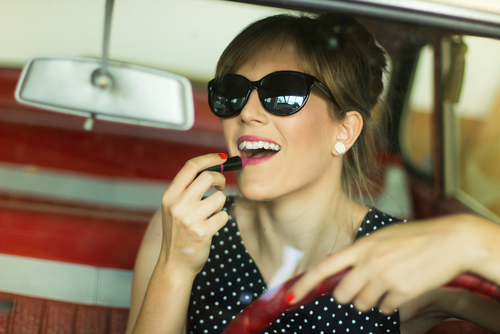
The price of many organic beauty products can be pretty off-putting, but what’s more off-putting are the potential health impacts of the toxic ingredients in many beauty brands. These are seven common offenders, how to spot them on the bottle, and some tips on choosing healthier beauty products.
7 Toxic Ingredients in Everyday Beauty Products

1. Parabens
Parabens have been getting a lot of attention lately, and with good reason. These toxic ingredients can disrupt hormones and act as a pseudo-estrogen, the latter of which is linked to all kinds of health problems. Some companies tout “natural” parabens, but natural doesn’t mean healthy. The best parabens in beauty products are none at all.
Common names: Obviously, anything with the word “paraben,” but also look out for PHENOIP, 4-HYDROXYBENZOIC ACID, P-HYDROXYBENZOIC ACID, 4-HYDROXY- ISODECYL ESTER BENZOIC ACID, and BENZOIC ACID

2. Perfluorinated Compounds
This family of chemicals make products resist stains, and you will find them in products from nonstick pans and fast food wrappers to clothing and nail polish. They are a likely carcinogen that are also linked to liver, kidney, and reproductive problems.
Common names: Teflon, ingredients with “fluoro” or “perfluoro” in the name

3. Triclosan
Triclosan is an antibacterial that’s a huge public health concern. Triclosan’s ubiquity is basically a breeding program for superbacteria that’s resistant to antibiotics and antibacterals. It’s in everything from hand soap to deodorant to toothpaste. If I had to pick one chemical to avoid at all costs, it would be this one.
Common names: triclosan, 2,4,4′-trichloro-2′-hydroxydiphenyl ether, 5-chloro-(2,4-dichlorophenoxy)phenol, trichloro-2′-hydroxydiphenyl ether, CH-3565, Lexol 300, Irgasan DP 300

4. Fragrance
If I had to pick a second ingredient to always avoid at all costs, it would be fragrance. The trick about “fragrance” on packaging is that it can really be anything. It could be natural and harmless, or it could be a known carcinogen. It’s a tricky way for cosmetics companies to hide some ingredients under a blanket term for “proprietary reasons.” I used to recommend looking for “free and clear” products to avoid fragrance, but even these sometimes contain fragrance. Reading the ingredients is your best bet.
Common names: fragrance, parfum

5. Ethanolamine Compounds
These toxic ingredients work as foaming agents. They can mix with other ingredients in beauty products to create harmful chemical reactions in your body. The real problem is that since beauty companies don’t have to disclose all of the chemicals they’re using, you can’t make a truly informed buying decision. Look for them in products like mascara, foundation, facial cleansers, and body wash.
Common names: DEA or Diethanolimine, TEA or Triethanolamine, Cocamide DEA or Cocamide Diethanolimine, Lauramide DEA or Lauramide Diethanolimine, DEA Lauryl Sulphate or Diethanolimine Sulfate, Linoleaide DEA or Linoleaide Diethanolimine, Oleamide DEA or Oleamide Diethanolimine, MEA, linoleamide MEA, stearamide MEA

6. 1,4 Dioxane
This toxic ingredient is a carcinogen used to make products foamier. Think things like soap, bubble bath, and even hair relaxers. Right now, 1,4 dioxane doesn’t have to be labeled, so it’s very hard to avoid in conventional beauty products.
Common names: sodium laureth sulfate, sodium lauryl sulfate, PEG compounds, chemicals that include “xynol,”, “ceteareth,” and “oleth” in the name

7. Butylated Compounds
Like parabens, these are preservatives used in cosmetics. Food companies also use butylated compounds to prolong shelf life. They are endocrine disruptors linked to organ damage. In fact, the EU has banned butylated compounds in cosmetics. They’re still allowed in the U.S. and are especially dangerous in products like lipstick or eye shadow.
Common names: BHA, BHT
Avoiding Toxic Chemicals in Beauty Products
So, how do we avoid these harmful chemicals? You have a few options!
1. Careful label-reading. The front of the package tells you very little about what’s in a product. Flip that puppy over and read the ingredients! Labels like “paraben free” or “natural” should be red flags, not comforting phrases.
2. Skin Deep Database. If you’re not familiar with the Environmental Working Group’s Skin Deep Database, it’s a great resource for finding safer cosmetics. You can plug in a product by name, and it gives you a safety rating.
3. Make your own! Of course, if you can’t afford organic beauty products, you can also balance out the cost by making some or all of your own beauty supplies. Try this homemade face scrub or this DIY deodorant, too!
Image Credits: parabens via Wikipedia; nail polish, deodorant, perfume mascara, bubble bath, and lipstick photos via Shutterstock

